Most telescopic rods fall apart within weeks – but these 6 survived my brutal durability tests. Find out which one is best suited for you below.
Last updated: November 21st, 2024
Video Review
If you prefer video, take a look at the YouTube video above where I reviewed several of the best telescopic fishing rods on the market.
Best Overall
KastKing Blackhawk II
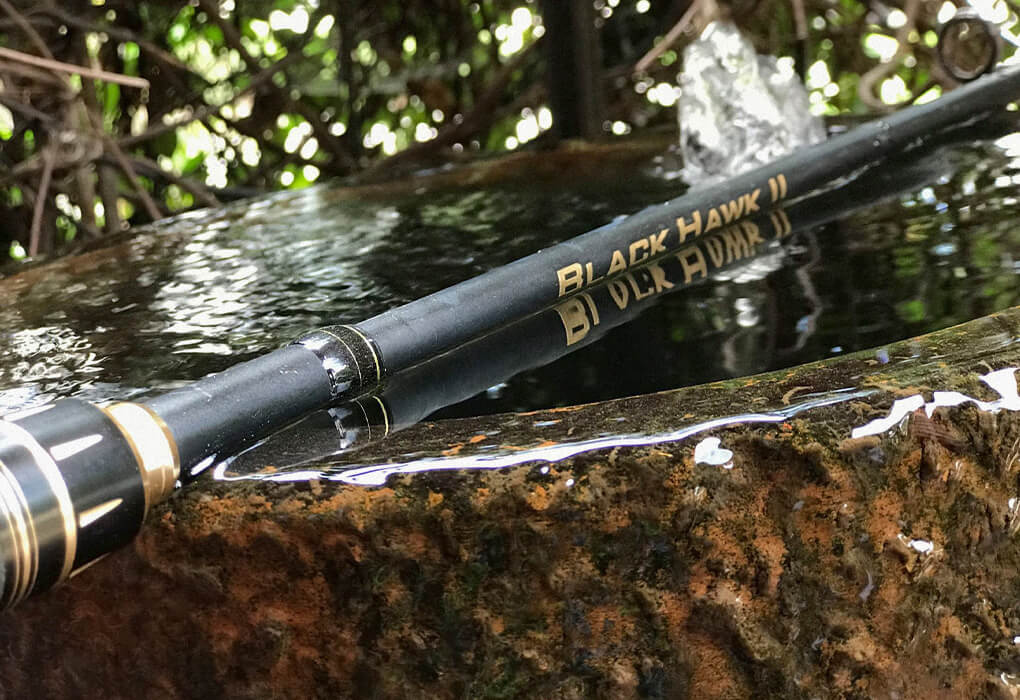
Specs
- Length: 6.6’ – 8’
- Weight: Varies
- Material: Graphite/Composite/Fiberglass
- Rod Type: Spinning and Casting
FEATURED SPECS
- This rod uses a graphite constructed blank with floating line guides to provide extra support to the tip of the rod. The guides are fixed like a normal rod to provide less friction on your cast.
EXTRA FEATURES
- It uses a soloscopic performance technology, which means that even though it’s a six-piece rod, it functions like a one-piece.
BUYING ADVICE
- This rod works best for a variety of purposes, so if you’re looking for a great travel rod that functions for surf, inshore, and freshwater fishing, this is the one.
Pros
- Great materials
- Many different size and method options
- Floating guides
- Small at collapsed length for travel
Cons
- Concerns over misaligned guides
If you read my reviews, you know my stance on telescopic rods. These are usually cheaply made, “gag” rods, as I would call them.
They’re not intended for real fishing but more so for hobbyists and people who travel a lot. But, I will say that this is the best telescopic fishing rod on the market, hands down.
The build quality is that of a premium rod, the guide design is beautiful, there are a million different size, power, and action combinations to appeal to anglers of all methods. It’s a great rod all around.
Best Combo
Kingswell Telescopic Rod and Reel Combo
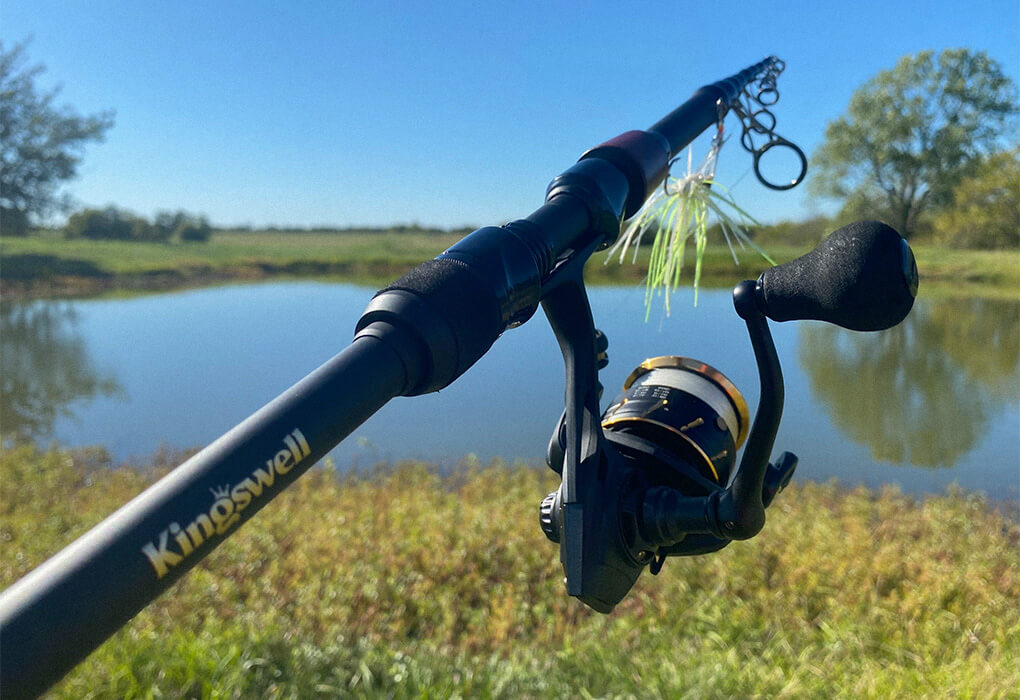
A picture I took while testing the Kingswell at my farm pond
Specs
- Length: 1′ 10″ to 6′ 9″
- Material: Carbon Fiber
- Rod Type: Spinning
Pros
- Rod and Reel Combo
- It comes with a carrying case
- Durable and lightweight
- Solid reel quality
- Fresh or saltwater
Cons
- Some of the eyes are difficult to keep straight while fishing.
- It is not intended for larger fish, such as Catfish.
Why We Chose It
The Kingswell spinning rod is made from Japanese 24/30 ultra-high-density carbon fiber, which is lightweight and strong.
I’m also a fan of the markings on the rod as they allow you to easily line the eyes up straight. The medium heavy stiffness of the rod makes it a great all-around telescopic rod (you can see what I’m talking about in the video below).
I took this to a local pond the first weekend I got it and found it was sturdy enough for bass fishing and it’s even sensitive enough for catching panfish.
I set the reel up to use as a right-handed angler but it’s easily interchangeable between right and left-handed reeling.
Once you have fully tightened the handle the Anti-reverse and drag work together to keep you from losing a fish while fighting it! The Kingswell is a great rod and reel for any fish under 20lbs.
It’s the smoothest casting telescopic rod and reel I’ve ever used and the casting distance is surprisingly far.
The reel is fluid with the 5+1 Stainless steel bearings that won’t rust or grind, even if you happen to drop it into the water!
This is the best option because you don’t have to worry about buying a separate reel that fits the rod; they come together.
The Kingswell telescopic rod and reel combo is ideal for the traveling angler looking to save space who doesn’t want to worry about having to pair a rod and reel.
Best Baitcasting
Aventur1 Telescopic Baitcasting Rod
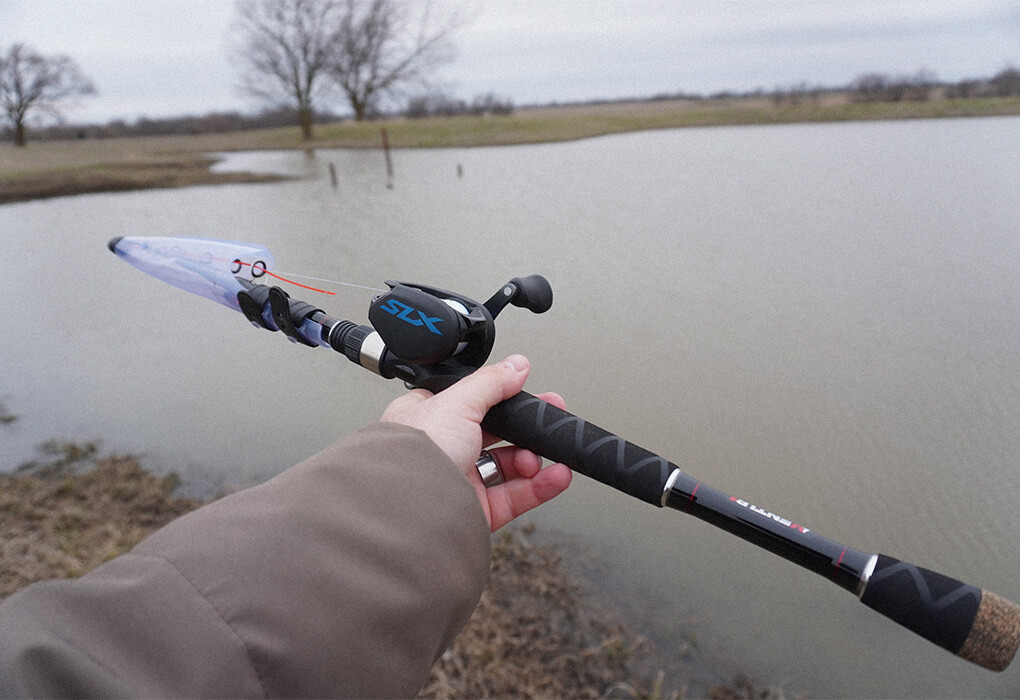
Me holding the Aventur1 before fishing with it on a cold winter day
Specs
- Length: 7′
- Material: RT2 Graphite
- Rod Type: Baitcasting
Pros
- Compact for storage and travel
- Good length and strength
- Casts good
- Solid all-around rod
Cons
- Expensive
- Only the rod
- Flimsy guides
Why We Chose It
While I won’t be rotating this in with my one-piece rods, it makes an excellent grab-and-go rod I can keep in my truck or pack for a camping trip.
The Bass Pro Shops Aventur1 telescopic casting rod is the traveling bass angler’s dream come true. It felt good in my hands while casting and reeling.
The 7′ length makes it ideal for a wide variety of bass fishing techniques and lures, plus you can choose your preferred power.
I like that I can easily store a 7′ rod in my and no one knows it’s there beside me, or I can keep it in a small closet without it getting in the way all the time.
It takes a little time to get the guides straight, so the rod casts well, and the eyes are a little soft, so they bend easily. I haven’t broken one off yet, but I feel it’s only a matter of time as often as I have to bend them back in place.
The Aventur1 is a little expensive, considering it’s only a rod, but it’s nowhere near the price of a high-end rod. So even if I end up breaking off a guide, I’m not going to go broke replacing it.
This rod is intended for the bass angler with limited storage options.
Best for Saltwater
MAGREEL 24T CARBON FIBER

Specs
- Length: 5.91’ – 10.82’
- Weight: Varies
- Material: 24T Carbon Fiber
- Rod Type: Casting and Spinning
FEATURED SPECS
- This saltwater fishing rod is made with 24-ton carbon fiber and a stainless steel reel seat. It possesses all the materials necessary to prevent saltwater corrosion.
EXTRA FEATURES
- It’s lightweight and used for a variety of fishing techniques, including inshore, offshore, and lake bass fishing.
BUYING ADVICE
- When shopping for a saltwater rod, you want to find something that uses corrosion-resistant materials. This one has all the nuts and bolts of a great saltwater rod.
Pros
- Top-notch materials
- Variable sizes
- Affordable for this quality
- Relatively durable
Cons
- The butt of the rod is small, which makes cranking hard
I’m a fan of this one because I think it uses the best materials you can get within this price range.
I’m just not familiar with the brand. 24-ton carbon fiber and stainless steel is the best money can buy, and you shouldn’t have any issues with the salt. Just make sure you buy a high-quality reel to go along with it.
For Freshwater
Quick Draw Telescopic Spinning Combo

A picture of me holding the fully collapsed Quick Draw rod and reel
Specs
- Length: 5′ or 6’6″
- Material: Graphite
- Rod Type: Spinning Combo
Pros
- Rod and reel combo, No need to guess which reel goes with it
- Fairly compact makes storage much easier
- Easy to cast for anglers of all skill levels
- Multiple actions and powers to choose from, so you can get what suits your needs
Cons
- Doesn’t look like a high-end rod and reel
- Easy to bend the eyes even with the provided rod tip protector
Why We Chose It
The Bass Pro Shops Quick Draw is a spinning rod and reel combo, so you don’t have to guess which reel goes best with the rod.
I’m not a huge fan of the rod tip protector; some of the other rods I tested had one that I liked much better because it also protected some of the eyes.
You can choose between a 5′ or 6’6″ length rod in multiple strengths that collapses to under 24″. It packs away quickly and easily; however, getting all of the eyes lined up takes a little bit of time.
After fishing with the rod, I thought it cast nicely. I was using a light lure, and I could cast it plenty far.
It didn’t handle a heavy lure or deep diving crankbait very well, so I recommend staying with smaller light lures.
It’s made from graphite, which isn’t the best or worse fishing rod material, but for the price, I’d say it’s worth it if you’re on a tight budget.
Best for Kids
Zebco 33
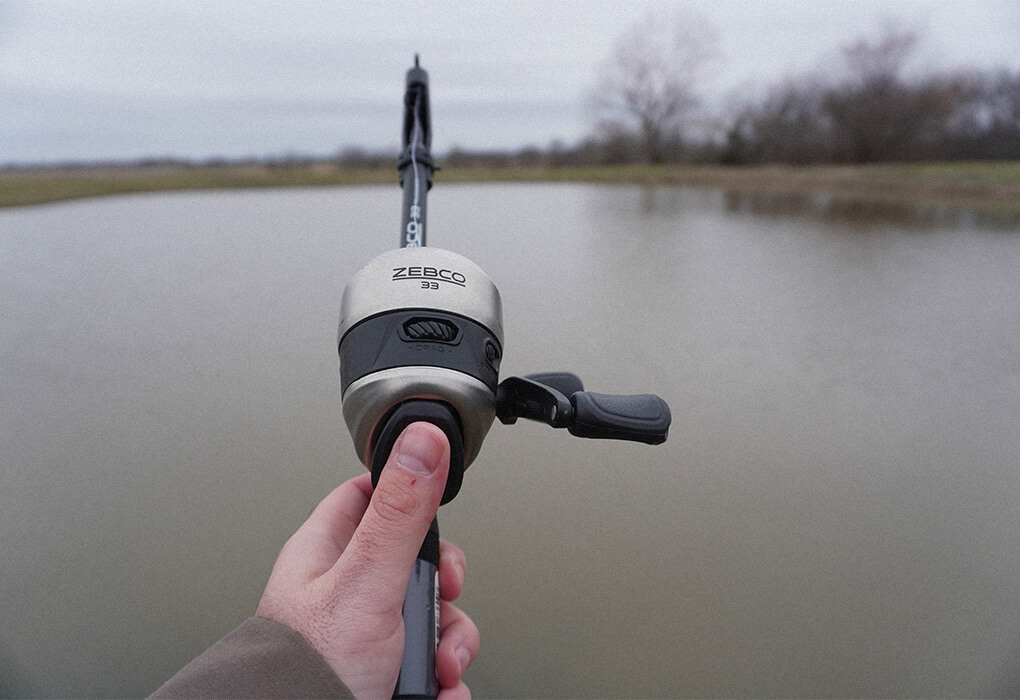
A picture of me holding a childhood favorite, Zebco 33, before testing it at a local pond
Specs
- Length: 6′
- Material: Fiberglass
- Rod Type: Spincast Combo
Pros
- Easy for kids to cast
- Compact for easy storage
- Rod and reel combo for a reasonable price
- Comes with line pre-spooled
Cons
- Flimsy, can’t handle big lures or big fish
- Difficult to line up the eyes straight
Why We Chose It
The Zebco 33 is one of the most iconic fishing reels on the planet.
I, along with millions of other anglers, learned to fish using one, so when you can pair up this kid-friendly reel on a telescopic rod, it’s perfect for those family camping trips where space is limited.
The oversized button is easy to press and cast. The rod stretches out to 6′ and collapses to 19″ so you can easily pack it in a backpack.
The lower price reflects that it’s not a high-quality rod and reel, but I wouldn’t want a kid fishing with my expensive rods anyways.
Though it has a rod tip protector and seems fairly tough, it can be replaced more than once without breaking the bank.
My daughter has no problems fishing with a Zebco 33 spincast rod and reel combo; however, if she were to hook into a 5+ pound fish, she would have a battle on her hands, and I’m not sure how many big fish this rod could handle, so I recommend putting small lures on to target the smaller fish.
This is a solid combo for introducing a kid to fish, without the gear taking up too much space in a closet or in the car while heading to your favorite spot.
Recent Updates
- Nov 21st 2024: Removed the Eagle Claw Pack-It as the “best budget” option because after additional testing, I’ve realized it breaks too easily.
- Nov 20th 2024: Removed the Leo Fishing Rod and Reel Kit as it’s no longer available.
Testing Procedures
- Location: To determine which is the best telescopic rod, I took them camping and fished with them in a few different spots, including my farm pond.
- Lures: I used different lures to test how well they cast light lures and determine if they could handle heavier lures.
- Fish: The most important part of the test, proved to be the most difficult because that depended on the fish and if they were willing to cooperate. Needless to say, I did catch fish with multiple rods.
- Features: I wanted a rod that could handle a variety of species such as bass, bluegill, crappie, catfish, and every species in between.
- It had to be compact and easy to transport.
- Lastly, it needed to be durable, I’m tough on my equipment, so it needed to be able to handle the abuse of getting tossed in the back of my truck or packed in the back of my SUV.
- It had to be compact and easy to transport.
- Watch: You can watch me on the water in my hands-on review of the best telescopic fishing rods in this video.
What is a Telescopic Fishing Rod?
A telescopic rod is one that collapses down so it can be stored and transported easily. These rods are made with multiple pieces in a tiered structure, which allows the rod to collapse on itself.
They each collapse down into the handle or the rod blank.
Then, when you’re ready to fish with it, you’ll expand the sections by pulling the rod out and extending it to its complete length.
This varies from a rod that has multiple pieces. Some traditional rods come in two or three-piece sections that you’ll take apart and carry separately.
These are not telescopic rods. Telescopic is one single rod composed of multiple sections, but it’s still only “one-piece.”
Most of these rods use a mixture of fiberglass and carbon fiber material, so they contain a lot of the same strength and durability as regular rods.
The reason they’re never as durable is simply the fact that they’re made with many different parts.
When you combine four or five pieces to make a rod, you’re creating weak points, which causes the rod to break easier, and it reduces the overall sensitivity, so they’re not usually as effective either.
You’ll also see telescopic rods called collapsible fishing rods, telescoping fishing rods, retractable fishing rods, and portable fishing rods.
I find that these are most popular among travelers who frequently move from one location to the other.
They don’t work with large fish or power applications because of their durability issues, but they’ll serve their purpose for someone who isn’t a “serious” angler and is simply looking to cast around every now and again.
Telescopic Fishing Rods vs. Traditional Rods

If we’re comparing the two, let’s look at a few different factors:
- Performance
- Convenience
- Durability
- Ease of use
Let’s break each one down in its own section so you can get a solid representation of whether or not the best collapsible fishing rod is the right choice for you.
Performance
Winner: Traditional Rods
No matter what telescopic rod you choose, the traditional fishing rod will always prevail.
Their performance cannot compare because you’re losing a lot of sensitivity due to the multiple pieces, and many of these cannot accommodate a decent fishing reel, which reduces the smoothness of your retrieval and impacts your presentation.
You lose flexibility in terms of what lures you want to use because you won’t be able to create a particular presentation, so you’ll have to “dumb down” how you present your lure to something a bit more simple.
Now, if you have a lot of experience, you’ll know how to handle the situation and choose something like a drop-shot rigged worm or a suspending jerkbait that doesn’t require much of a presentation.
But, no matter what way we try to play this, traditional rods will always outperform because they’re smoother, more sensitive, and they provide more options.
Convenience
Winner: Telescopic Rods
If you didn’t know yet, telescopic rods are easier to transport, simpler to walk around with, and more convenient if you have a lot to carry.
Most of these come with carrying bags so you can store everything in one place, and some of them don’t even require you to purchase lures, reels, or anything for that matter.
To the experienced anglers like myself, these are “gags,” as I like to call them. They’re cheap materials, cheap rods, cheap reels, and cheap lures.
Do they get the job done 75% of the time? Yes, they do, but that other 25% is where serious anglers live, and these rods aren’t good enough.
If you fish a few times a year with a cooler full of beer and three of your best buddies, these rods will take care of business.
Durability
Winner: Traditional Rods
This factor is somewhat obvious, as well. Telescopic rods are the least durable option money can buy.
When you take multiple pieces and combine them to create something that needs to function as “one-piece,” you’ll never be able to catch anything large or battle fish that put up much of a fight.
Durability is a consistent issue with telescopic rods and a reason that I usually avoid them. I’d rather purchase a high-quality rod and reel combo or bass rod any day before one of these.
Ease of Use
Winner: Tie
What defines ease of use for one is different for another. I don’t want to go out on a limb and say that telescopic rods are easier because that’s not always true.
It’s important to keep in mind how corrosion will impact the performance of a fishing rod.
If you’re using these for saltwater or you’re not maintaining them properly, they’ll become brittle and different to open and close, which will decrease the ease of use versus a traditional rod.
As for traditional rods, they might not be as easy to transport as your typical travel rod, but they’re easier to use because they’re simpler to operate.
If you get a standard two-piece rod, you can still travel with them, but you need to be more careful about where you store them because they’re not collapsible.
Overall, I can’t pick a winner on this because it depends on the individual and how you intend to fish with these rods.
How to Choose the Best Telescopic Fishing Rod

When you’re choosing a portable fishing rod, there are some things you should consider. Let’s take a look at all the factors I would consider before purchasing.
Sections
The number of sections is important because it will determine how many weak spots you have in your rod. Most telescopic poles are four, five, or six sections. The less, the better, but that might also impact the total length of your rod.
Of course, we’re nickel and diming because it may only vary by an inch or so in collapsed length, but that inch might matter for some of you.
Overall, I’d recommend going with as few sections as possible to get the most durable rod. The total length won’t matter if the rod snaps in half.
Extended vs. Collapsed Lengths
This point goes hand-in-hand with the previous. The total length of your rod is important for both travel and when you’re on the water. Keep in mind what you intend to do with your fishing rod.
If you’re trying to find something for surf fishing, you’ll need a pretty long rod of at least eight feet because you need that extra distance to cast beyond the surf.
If you’re trying to fish small backwater ponds for bass, you can go with something much shorter, which will likely impact both your extended and collapsed length.
A lot of people use these rods for frequent traveling or nomadic lifestyles. If that’s the case, weight might also be a factor.
Materials
Most telescopic rods are made with fiberglass, carbon fiber, or a combination of the two. You want to find high tensile materials that are rated for the highest weight possible if you’re trying to maximize durability.
Keep in mind that as you increase durability through heavier materials, you’re also creating a rod that will weigh more, which may not be ideal if you’re traveling or walking long distances and trying to limit the weight of your gear for backpacking.
There’s an endless scale that tips down on one side and raises on the other when it comes to these types of rods. Keep weighing the pros and cons to come to a confirmed decision.
Weight
The weight of your telescopic rod is important because most people buy these to find something that is lightweight.
Granted, few telescopic rods weigh more than two pounds, so they’re all relatively light. Just remember that light is good but also bad.
If you’re thinking of using crankbaits, stickbaits, or other heavy power baits, you’re going to run into some trouble.
You might be able to cast and present them, but if anything hefty strikes you, you’re gonna have quite a battle on your hands.
Many of these rods are ultralight medium-heavy action blanks, so they bend a lot, but they’re meant for smaller fish to prevent damage.
They will break if you’re not careful, and most of the negative reviews and bad stigma you might revolve around people who didn’t understand what they were getting into.
I’d suggest trying to find a telescopic rod that is moderate in weight, size, and functionality.
Most of the recommended options above, especially the KastKing Blackhawk II Telescopic Fishing Rod and the PLUSINNO Fishing Rod and Reel Combo, will handle a sizable fish, and they aren’t hard to transport.
Accessories Included
Accessories are fun, but if you follow my reviews, you know how I feel about them. I highly dislike buying rods that come with anything else other than a rod.
In most cases, rod and reel combos are cheap materials combined to increase the overall price and value of the purchase.
Whenever you get lures, hooks, and line with a rod or reel, they’re the lowest quality possible and will only get the job done for people who aren’t actually trying to catch anything.
That said, if you’re shopping for convenience and you’re not on the water to catch a trophy size fish, they’ll work. Consider what you have at home.
If you don’t have any tackle, purchasing a package deal will help you get started with the necessary pieces of equipment you need to go on the water and try to catch something.
If you have a lot of gear already, don’t think that you’re getting a deal by purchasing a kit. All you’re getting is a lot of junk.
Purpose and Intention
Last but not least, my favorite thing to discuss. I like anglers to niche up and specialize in something. Me, I like to consider myself a finesse angler.
I fish for bass with lightweight lures, ultralight rods, and high gear ratio reels. I do this when the water is a bit cooler at times when bass aren’t biting. This is when I like to fish, and that’s how I do it.
If you had to describe yourself, how would you do so?
If nothing comes to mind. Then go with one of the fishing kits above, and don’t worry about it. But, if something does pop into your head, make sure you use it to guide your decision.
If you like fishing crankbaits and suspended lures, you’ll need something with a bit more guts, so choose a heavier and longer telescopic rod.
Suppose you prefer to fish saltwater and inshore canals throughout Florida as an example. In that case, you’ll need a corrosion-resistant rod, and you’ll want to avoid the kits because those lures won’t hold up in saltwater anyway.

It’s important to understand that manufacturers create these rods with everyone as their target, but they don’t work for everyone.
Amateur anglers don’t really have to worry about this, but if you’re serious about your fishing and you’re looking for something that you can travel with, you’ll want to be a bit pickier.
Frequently Asked Questions
What is the best telescopic fishing rod?
The best option is the KastKing Blackhawk II Telescopic Fishing Rod, hands down. It comes in varying lengths between 6.6 and 8 feet, which provides options for both fresh and saltwater.
Plus, it’s made with high-quality carbon fiber and fiberglass materials, which maximize strength while also limiting excess weight for transportation.
Are telescopic rods good or bad?
There’s really no such thing as a “bad” rod. Each rod has a purpose and an intent, and if you try to use one outside of its realm of purpose, it won’t work. That’s what people do all the time.
People take a five-foot fiberglass rod with aluminum oxide guides and try to catch Tarpon with it. Then they complain when it rusts and snaps after two fishing trips.
If you read this guide, you should know what you’re getting into with a telescopic rod. They’re not the most durable rods out there, so you can’t push them.
But, if you’re looking for something that’s easy to transport and good enough for occasional fishing, you’re in the right place.
Can you catch big fish with a foldable fishing rod?
Yes, but you’re teetering on a fine line. It all depends on the scenario.
I’ve caught six-pound bass on a two-pound trout line with an ultralight rod, but that doesn’t mean I would suggest doing it.
If you take care of the telescopic rod, clean it after use, dry it thoroughly, and lubricate the unions, you could probably fish power baits, but why bother?
If you’re trying to catch larger fish, you’ll need the right reel and a proper rod for it. These would not be my first, second, or third choice.
Should you get a telescopic rod with or without a reel?
Again, it all depends on what you’re doing with it. If you don’t have any fishing gear and this is your starting point, absolutely get the reel.
Buying a kit will give you everything you need to get started, and you won’t have to worry about matching rods and reels without experience.
If you’re looking for something cheap, this is also a great way to get everything for less than $50. A decent rod and reel will easily cost you $200-400.
You don’t want to spend that on a weekend company fishing trip.
That said, if you fish a lot and you’re considering a telescopic rod, but you already have a reel in mind, just make sure that the reel seat leaves enough room to accommodate the reel you’re considering.
Most of these should, but be sure to do a little research on that.
Conclusion
By this point, you should understand everything about telescopic rods. You should know why you would want one, how to fish with them, and which one you might want to buy.
As I’ve stated many times, factor in your fishing style, technique, and intention before making a purchase.
If you’re a weekend warrior or someone fishing on occasion, go with one of the choices above. If you’re thinking about taking the sport seriously, you might want to check out some of my other reviews.
Overall, the best telescopic fishing rod is not hard to find, and there are more than enough options to go around. Give some of these choices a deeper look, and have a safe trip to wherever the water takes you! Good luck out there.


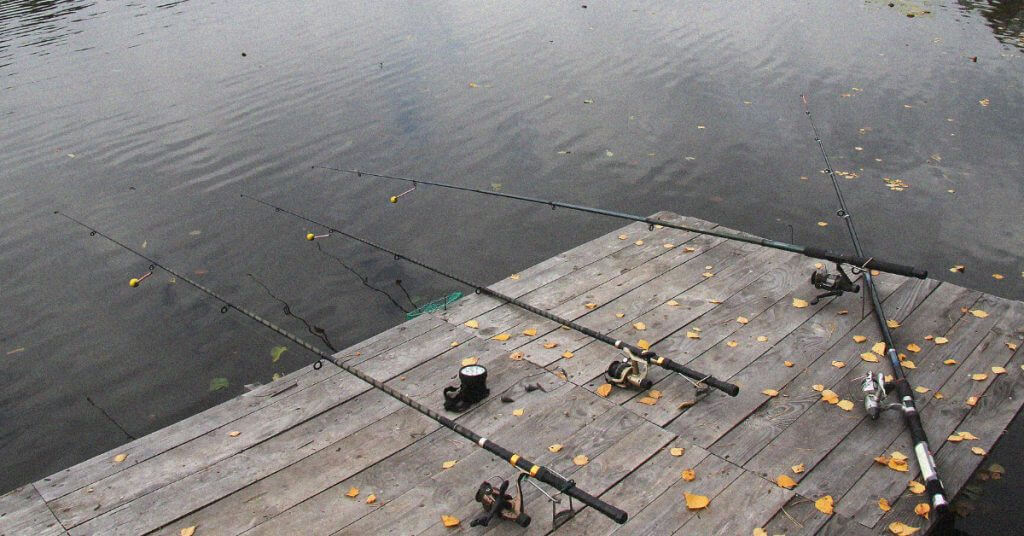
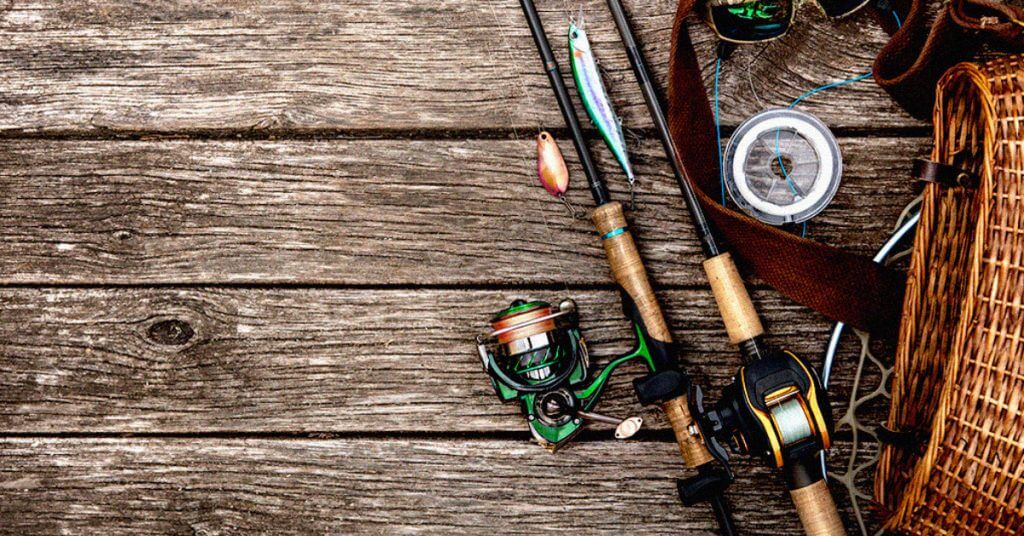

Thank you for very informative and comcise, and honest opinions on these rods and combos.
Thanks for reading Mark! Telescopic rods have their place and time but you’ve got to search pretty hard to find the diamonds in the rough.
Years ago I bot an 8ft one piece telescopic bait cast rod that consisted of only 2 sections. The bottom section was the long cork handle and half of the rod with one line guide and the top section with line guides small enough to fit into the bottom section. Collapsible length was a little over 4 feet. Cannot find anything like that. Anyone know where I might be able to find one or something similar?